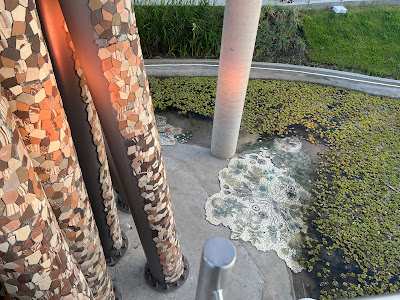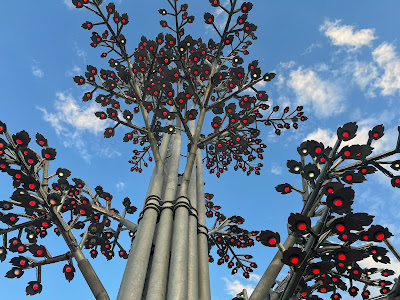The city and the Arborea Magna during the golden hour. All photos by Myriam Mahiques, January 2024, personal archives. Do not share without permission.
When I travel to Buenos Aires, I usually meet my architect friends and we visit places together to learn more about architecture, the last contemporary designs, recycling and last technologies.
One of those visits has been the Parque de la Innovación, across the River Stadium in the neighborhood of Nuñez, Ciudad Autónoma de Buenos Aires.
It was a real challenge in Summer since the park was full of mosquitoes, but we were coming back from the Ciudad Universitaria and took the opportunity to see the Arborea Magna, a sculpture tree designed by artist Nicola Constantino. Overall, I like it as an urban monument, but there are some details that could have been improved.
The technical information I share here is taken from the Internet, but my goal was to see if the new tree would affect the urban profile, and yes, it did, and I enjoyed taking photos during the sunset, when the sun is seen between towers and the colorful changing lights of the tree are on.
So I walked around, took the ramp up to the tree, and tried to get a new perception of the city behind the "technical" or "robotic" branches. I was quite a different view. Of course I don't know if the artist has taken into account the location of the (hybrid) tree among the towers behind, since they are far away, but it feels like there is no limit and the park is conceptually extended and reaches the city.
The tree seems to be emerging from the water, but I should say a pond. I think this "emergence" idea is not totally achieved. First of all because the water cannot be seen unless you get very close to it or you are right above. The aquatic plants are pretty camouflaged with the grass around and there is not enough water for the scale of the tree. This is the main reason for which I see the tree more related to the city rather than part of the nature or the environment (as Nicola sees it).
Per Clarin.com the branches have 754 LED synchronized lights, the trunk is built with 16 galvanized iron tubes that reach 34 meters in height. They are covered in a ceramic collage with tiny pieces up to 2 meters. The columns below the ramp, are competing with the tree tubes and the idea of "nature" or "monument" or "robot" is not clear. Though Nicola says there is a mystical concept in this tree:
“Es un híbrido de todos los árboles, por eso de que el árbol es un elemento tan místico porque tienen las raíces que van al centro de la tierra y las ramas que van hacia arriba, una antena en la Tierra con lo divino, algo muy fuerte en todos los ámbitos para la humanidad”. (From Clarin.com).
The columns look oversized compared to the iron tubes and in my opinion, the engineers must have oversized them on purpose. From an architectural and artistic point of view, the ramp could have been supported by other means. In my mind, I imagine a Nautilus around, reaching the ground due to its shape, not with columns. Or the tree could have intercepted the ramp directly, the way a real tree would have grown up in wilderness, without impediments, then the tubes would become the structural part of the ramp as well.
The ceramic art at the bottom intersecting the water and the concrete foundation is really beautiful. It is better appreciated from the balcony around. Here we can see how the ramp structure is mixed with the tubes. Not a happy solution, it's confusing. We may ask "is it part of the trunk?". Of course not.
The tree branches with an instant of red light, as seen from below.
The ceramic liner on the iron tubes.
This picture is one of my favorite. The vertical city as seen through the green branches. When I see the branches combined with the guardrails, there is no way I can imagine the tree as a mystical part of nature.
People enjoying the view and some take selfies.
Ceramic art below, close to the pond.
This is a very nice view, and the yellow looks great against the blue sky.
The illumination from below. Should it be hidden, disguised? Maybe.




















No comments:
Post a Comment